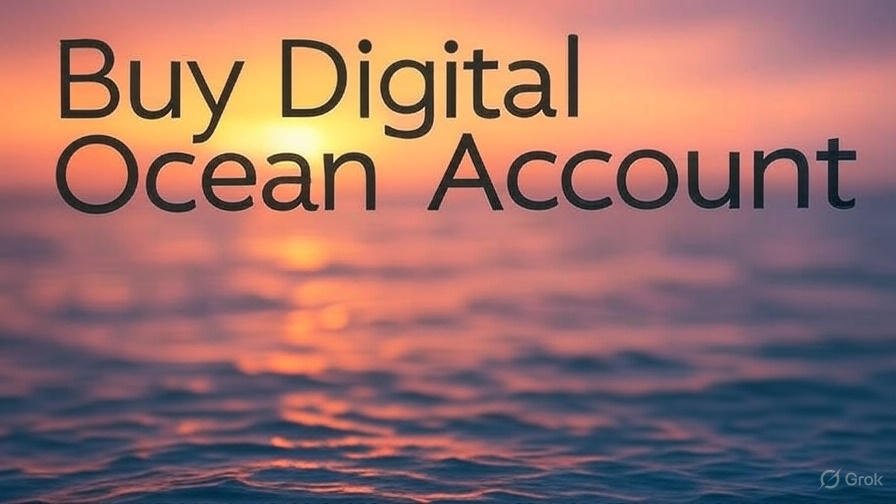In the wake of DigitalOcean’s robust Q2 2025 earnings report, where the company announced revenue of $219 million—a 14% increase year-over-year—and raised its full-year guidance to between $888 million and $892 million, the cloud provider continues to attract developers and businesses seeking affordable, scalable solutions. Net income surged 93% to $37 million, driven by strong demand for AI/ML workloads and GPU offerings. This financial momentum underscores DigitalOcean’s position as a developer-friendly alternative to larger hyperscalers. However, as interest grows, so does the market for third-party buy DigitalOcean accounts, prompting users to carefully evaluate their options.
Whether you’re creating a new account directly or considering purchasing one, understanding critical factors like verification, support, resources, and potential risks is essential. This expert guide, informed by official DigitalOcean documentation and recent industry insights, provides a comprehensive overview to help you make an informed decision. We emphasize that DigitalOcean’s terms of service prohibit account transfers or sales, and buying from third parties can lead to suspension or loss of access. Always prioritize official channels for the best security and compliance. For more on cloud security best practices, check out Cloud Security Alliance.
The Rising Popularity of DigitalOcean in 2025
DigitalOcean’s appeal stems from its simplicity, predictable pricing, and focus on developers. With features like Droplets, managed Kubernetes, and now enhanced GPU Droplets for AI tasks, the platform supports a wide range of applications from web hosting to machine learning. Recent updates, including the Hatch program offering AI startups up to $100,000 in credits, highlight its commitment to innovation.
While signing up directly grants new users $200 in free credits over 60 days, some seek pre-configured or verified accounts from resellers to accelerate setup. However, community discussions reveal significant risks, including account lockouts and security breaches when dealing with unauthorized sellers. As DigitalOcean’s stock receives buy ratings amid growth, ensuring your account aligns with best practices is more important than ever.
Key Factor 1: Account Verification and Security
Security starts with verification. DigitalOcean requires new users to provide payment details to prevent abuse, and accounts may be locked during signup if flagged, necessitating support intervention. For optimal protection, enable multi-factor authentication (MFA) immediately upon creation. DigitalOcean supports TOTP apps, SMS, and backup codes, with experts recommending TOTP for its resistance to SIM-swapping attacks.
When considering a purchase, insist on proof of legitimate ownership and secure transfer processes. However, as per DigitalOcean’s policies, accounts are non-transferable, and attempting this can result in deactivation. Best practices include regularly reviewing login activity and security history in the dashboard, changing passwords post-acquisition, and implementing SSL/TLS for all data transmissions. In 2025, with rising cyber threats, encryption for data at rest and in transit is non-negotiable.
To illustrate security layers, consider this table of recommended practices:
| Security Feature | Description | Why It Matters |
|---|---|---|
| MFA (Multi-Factor Authentication) | Requires secondary verification beyond password. | Prevents unauthorized access even if credentials are compromised. |
| Login History Review | Monitor recent logins and devices. | Detects suspicious activity early. |
| SSL/TLS Encryption | Encrypts data between clients and servers. | Protects against man-in-the-middle attacks. |
| Firewall Configuration | Use DigitalOcean Cloud Firewalls to restrict traffic. | Limits exposure to potential threats. |
Key Factor 2: Customer Support and Reliability
DigitalOcean’s support ecosystem is tiered to meet varying needs. The free Starter plan includes email support and community resources, while paid options—Developer ($24/month), Standard ($99/month), and Premium ($999/month)—offer faster responses, live chat, and dedicated managers. Premium users benefit from 30-minute initial response times for critical issues, essential for production environments.
If buying an account, ensure support access isn’t compromised. Official accounts allow ticket submission even without login via a dedicated form. Recent user experiences emphasize the value of 24/7 availability, particularly for DDoS mitigation and GPU configurations. In 2025, with AI integrations, support for specialized workloads like bare metal GPUs is a key differentiator. For insights on optimizing cloud support, explore TechTarget’s guide on cloud support.
Key Factor 3: Available Resources and Scalability
Evaluate resources to ensure they match your needs. Droplets start at $4/month, with GPU options from $0.76/GPU/hour for AI tasks. Managed databases ($15/month) include automated backups, while Spaces object storage is $5/month with built-in CDN. Free features like ingress data transfer, VPCs, and three static sites enhance value.
For scalability, look for accounts with monitoring tools, load balancers ($12/month), and Kubernetes ($12/month with free control plane). Predictable pricing with monthly caps prevents bill shocks, and overages are minimal at $0.01/GiB for egress.
Understanding the Risks of Third-Party Purchases
Buying a DigitalOcean account from third parties carries substantial risks. Reports indicate cases of account deactivation without warning, as DigitalOcean may flag transferred accounts as fraudulent. Security vulnerabilities arise if sellers retain access, leading to hacks or data loss. Additionally, you may lose control over domains or emails if not properly transferred. Experts advise against this, recommending direct sign-ups to maintain ownership and avoid compliance issues.
- Account Suspension: Violations of terms can lead to immediate lockout.
- Financial Loss: Pre-paid credits or resources may be inaccessible.
- Security Breaches: Shared credentials increase hack risks.
- Support Limitations: Third-party issues may not be covered.
Best Practices for a Secure and Effective DigitalOcean Experience
To maximize your investment, follow these 2025 best practices:
- Sign up directly at DigitalOcean.com for $200 credits.
- Implement logging and monitoring via the dashboard.
- Use cloud firewalls and VPCs for network isolation.
- Regularly backup data with automated options (20-30% of Droplet cost).
- Integrate with tools like Terraform for infrastructure as code.
Encrypt everything: Use Let’s Encrypt for free SSL on load balancers and enable disk encryption for volumes. For teams, leverage role-based access controls to minimize privileges.
Conclusion: Prioritizing Safety in Cloud Choices
As DigitalOcean thrives in 2025 with AI-driven growth and solid financials, choosing the right account setup is pivotal. Focus on verification, support, and resources while avoiding third-party risks to ensure a trustworthy, high-performance cloud experience. For the latest, consult DigitalOcean’s official resources. This guide is for informational purposes; always verify with primary sources.

